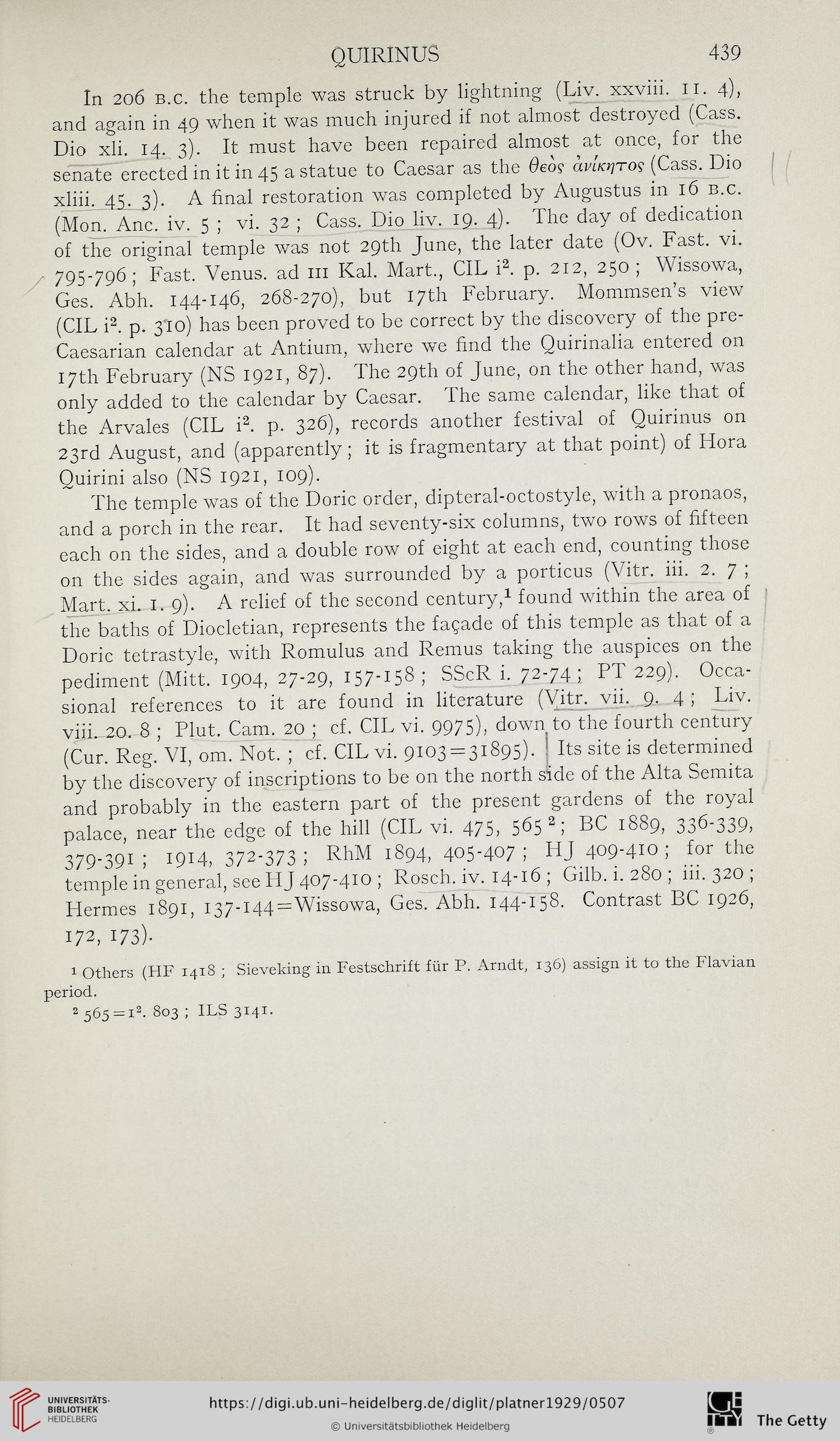QUIRINUS 439
In 206 b.c. the temple was struck by lightning (Liv. xxviii. 11. 4),
and again in 49 when it was much injured if not almost destroyed (Cass.
Dio xli. 14. 3). It must have been repaired almost at once, for the
senate erected in it in 45 a statue to Caesar as the θβος ανίκητος (Cass. Dio
xliii. 45. 3). A final restoration was completed by Augustus in 16 b.c.
(Mon. Anc. iv. 5 ; vi. 32 ; Cass. Dio liv. 19. 4). The day of dedication
of the original temple was not 29th June, the later date (Ov. Fast. vi.
795796; Fast. Venus, ad 111 Kai. Mart., CIL i2. p. 212, 250 ; Wissowa,
Ges. Abh. 144-146, 268-270), but 17th February. Mommsen’s view
(CIL i2. p. 310) has been proved to be correct by the discovery of the pre-
Caesarian calendar at Antium, where we find the Quirinalia entered on
17th February (NS 1921, 87). The 29th of June, on the other hand, was
only added to the calendar by Caesar. The same calendar, like that of
the Arvales (CIL i2. p. 326), records another festival of Quirinus on
23rd August, and (apparently; it is fragmentary at that point) of Hora
Quirini also (NS 1921, 109).
The temple was of the Doric order, dipteral-octostyle, with a pronaos,
and a porch in the rear. It had seventy-six columns, two rows of fifteen
each on the sides, and a double row of eight at each end, counting those
on the sides again, and was surrounded by a porticus (Vitr. iii. 2. 7 ;
Mart. xi. I. 9). A relief of the second century,1 found within the area of
the baths of Diocletian, represents the fagade of this temple as that of a
Doric tetrastyle, with Romulus and Remus taking the auspices on the
pediment (Mitt. 1904, 27-29, 157-158; SScR i. 72-74 ; PT 229). Occa-
sional references to it are found in literature (Vitr. vii. 9. 4 ; Liv.
viii. 20. 8 ; Plut. Cam. 20 ; cf. CIL vi. 9975), down to the fourth century
(Cur. Reg. VI, om. Not. ; cf. CIL vi. 9103 = 31895). Its site is determined
by the discovery of inscriptions to be on the north side of the Alta Semita
and probably in the eastern part of the present gardens of the royal
palace, near the edge of the hill (CIL vi. 475, 5G5 2; DC 1889, 336-339,
379-391; 1914, 372-373; RhM 1894, 405-407; HJ 4O9-4IO; for the
temple in general, see HJ 407-410 ; Rosch. iv. 14-16 ; Gilb. i. 280 ; iii. 320 ;
Hermes 1891, i37-i44=Wissowa, Ges. Abh. 144-158. Contrast BC 1926,
172, 173)·
1 Others (HF 1418 ; Sieveking in Festschrift fur P. Arndt, 136) assign it to the Flavian
period.
2 565 = i2. 803; ILS 3141.
In 206 b.c. the temple was struck by lightning (Liv. xxviii. 11. 4),
and again in 49 when it was much injured if not almost destroyed (Cass.
Dio xli. 14. 3). It must have been repaired almost at once, for the
senate erected in it in 45 a statue to Caesar as the θβος ανίκητος (Cass. Dio
xliii. 45. 3). A final restoration was completed by Augustus in 16 b.c.
(Mon. Anc. iv. 5 ; vi. 32 ; Cass. Dio liv. 19. 4). The day of dedication
of the original temple was not 29th June, the later date (Ov. Fast. vi.
795796; Fast. Venus, ad 111 Kai. Mart., CIL i2. p. 212, 250 ; Wissowa,
Ges. Abh. 144-146, 268-270), but 17th February. Mommsen’s view
(CIL i2. p. 310) has been proved to be correct by the discovery of the pre-
Caesarian calendar at Antium, where we find the Quirinalia entered on
17th February (NS 1921, 87). The 29th of June, on the other hand, was
only added to the calendar by Caesar. The same calendar, like that of
the Arvales (CIL i2. p. 326), records another festival of Quirinus on
23rd August, and (apparently; it is fragmentary at that point) of Hora
Quirini also (NS 1921, 109).
The temple was of the Doric order, dipteral-octostyle, with a pronaos,
and a porch in the rear. It had seventy-six columns, two rows of fifteen
each on the sides, and a double row of eight at each end, counting those
on the sides again, and was surrounded by a porticus (Vitr. iii. 2. 7 ;
Mart. xi. I. 9). A relief of the second century,1 found within the area of
the baths of Diocletian, represents the fagade of this temple as that of a
Doric tetrastyle, with Romulus and Remus taking the auspices on the
pediment (Mitt. 1904, 27-29, 157-158; SScR i. 72-74 ; PT 229). Occa-
sional references to it are found in literature (Vitr. vii. 9. 4 ; Liv.
viii. 20. 8 ; Plut. Cam. 20 ; cf. CIL vi. 9975), down to the fourth century
(Cur. Reg. VI, om. Not. ; cf. CIL vi. 9103 = 31895). Its site is determined
by the discovery of inscriptions to be on the north side of the Alta Semita
and probably in the eastern part of the present gardens of the royal
palace, near the edge of the hill (CIL vi. 475, 5G5 2; DC 1889, 336-339,
379-391; 1914, 372-373; RhM 1894, 405-407; HJ 4O9-4IO; for the
temple in general, see HJ 407-410 ; Rosch. iv. 14-16 ; Gilb. i. 280 ; iii. 320 ;
Hermes 1891, i37-i44=Wissowa, Ges. Abh. 144-158. Contrast BC 1926,
172, 173)·
1 Others (HF 1418 ; Sieveking in Festschrift fur P. Arndt, 136) assign it to the Flavian
period.
2 565 = i2. 803; ILS 3141.




